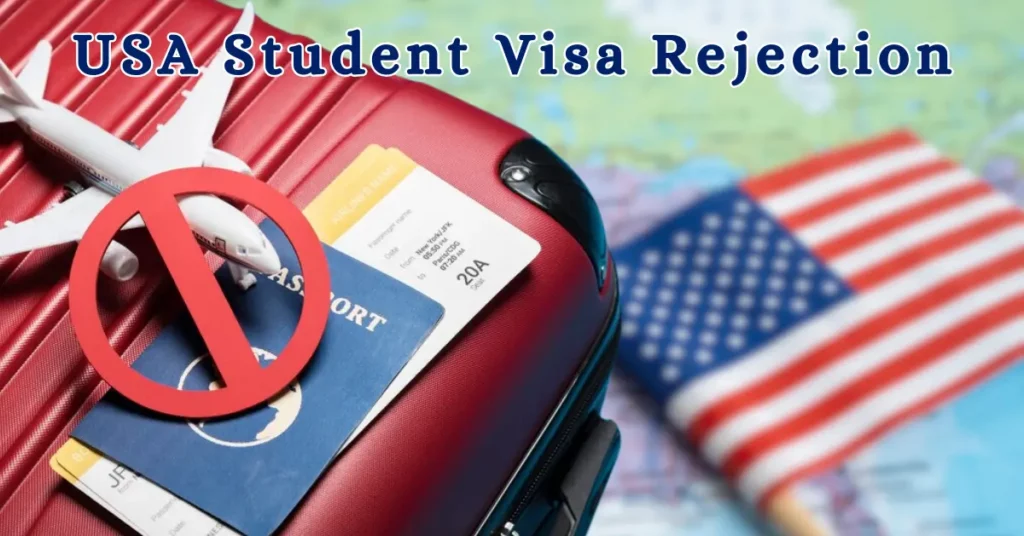
Table of Content
- Types of US Student Visas
- Role of the US Embassy in US Visa Rejection
- Common Reasons for US Student Visa Rejection
- What to do if a US Student Visa is Rejected?
- How Many Times Can You Apply for a US Student Visa?
- Tips to Avoid a US Student Visa Rejection
- Frequently Asked Questions
According to a report by Education Times, 130,839 F-1 student visas were issued to Indian students in the United States in 2023, representing a 14% increase compared to the previous year. However, a significant number of US student visa rejections is also a fact that cannot be ignored. Individual agencies report that the rate of student visa rejection in the US is 36.26% in 2023, which was 2% lower than the previous year.
Identifying and resolving the issues can save you from rejection. The reasons for US student visa rejections are common and can be avoided with a serious approach and careful application review.
US Student Visa Updates for 2025
F1 Visa Appointments:
- F1 visa appointments for Spring 2025 intake are available at the US Embassy in India.
- Due to high demand, book appointments between September and December 2024 to increase your chances.
Changing Designated Learning Institutions (DLIs):
- Students can transfer to a new school before receiving a new study permit if they:
- Apply for a new permit through an extension.
- Have a Letter of Acceptance (LoA) from the new DLI.
- Hold a valid permit without the new DLI listed.
English Language Proficiency:
- Prove fluency through tests like TOEFL, IELTS, PTE, or Cambridge exams (C1 or C2).
- Score requirements vary by institution.
Financial Proof:
- Show evidence of funds to cover tuition and living costs, such as bank statements, scholarships, or sponsor documents.
Types of US Student Visas
In the US, there are 3 types of visas for international students: F-1, M-1, & J-1. Among them, the F-1 visa is the most common to undertake full-time degree or diploma courses in the US.
| Student Visa Category | Purpose | Maximum Validity |
| F-1 | Full-time study in the US for courses like a degree or diploma. | 5 years |
| M-1 | Vocational or non-academic study in the US. | 1 year |
| J-1 | Exchange study in the US for a short period. | 12 – 18 months |
Role of the US Embassy in US Visa Rejection
Under section 104(a) of the Immigration and Nationality Act, consular officers at U.S. Embassies and Consulates are exclusively authorized to adjudicate (approve or deny) visa applications. If you are found ineligible after the interview, the consulate can cancel your visa application.
Common Reasons for US Student Visa Rejection
A student visa in the US can be rejected due to errors in application, documentation, lack of finances, and other reasons. Since most students apply for an F-1 visa in the US, given below are the top reasons for an F-1 visa rejection. Remember, the same reasons are also applicable to the other student visa categories like M-1 and J-1.
F-1 Visa Rejection Reasons
An F-1 visa is provided if the applicant proves their candidacy by adhering to the guidelines and proper document submission. Here are the common reasons for F-1 visa rejection in the US.
Non-Compliance with US Visa Regulations
If your application doesn’t comply with the study visa regulations, it can lead to a rejection. The rules and regulations are set by the US immigration authorities to ensure a smooth process. Make sure your application adheres to the regulations.
Failure to Submit an Acceptance Letter or Form I 20
An offer letter or Form I-20 is proof that an applicant is admitted to a US university. When you apply for an F-1 student visa, failure to submit an admission letter or Form I-20 can result in visa rejection.
Stay Back Intentions
Students are not supposed to stay back in the US after their studies. In your F-1 interview, if you express any plan to stay back in the US, you might face a study visa rejection. Instead, talk about your return plans and future course of action in your home country.
Lack of Funds
International students must submit proof of funds when they apply for a US student visa. The amount equals the cost of attendance for a year specified in their Form I-20. Lack of funds or unclear financial sources is an immediate reason to reject your US student visa application.
Poor Documentation
Proper submission of your documents, such as academic records and financial documents, is a roadblock to a successful visa application. Before submitting your documents, carefully examine them for proper documentation.
Unclear Academic Program Choice
In your interview, talk clearly about the reasons to choose a particular program in the US. Lack of clarity regarding your program choice and career goals can negatively impact your US student visa.
Gap Years
If you have gap years in your academic career, you must explain them conveniently during the interview. Without a proper explanation, gap years in academics can be another reason to reject your visa application to study in the US.
Medical Issues
While applying for an F-1 visa, students must submit their medical records to prove physical fitness to study in the US. Provide your medical certificates correctly to avoid the chances of a rejection.
Ties with Home Country
Connected to your stay-back intentions, you must explain your ties with your home country. It conveys you have valid reasons to return after the completion of your education in the US. You can talk about your family connections, business intentions, and future vision.
Past Criminal Records
An applicant must be legally acceptable to get a US student visa. People with existing criminal records can’t apply for one. If you have any cases against you, get a clearance certificate before you apply for a visa.
What to do if a US Student Visa is Rejected?
You can re-apply for a US student visa 3 days after you receive the denial notice. We would suggest not applying again since an immediate denial is a minus in your application.
- Identify why your application was rejected and start working on rectifying them. The consular officer should provide you with a rejection notice, often referred to as a 214(b) refusal, which outlines the reasons for your visa denial. Carefully review this notice to understand the specific grounds for the decision.
- Re-apply, ensuring zero errors. For that, take help from Nomad Credit, your study abroad partner. Our expert solutions at zero cost assist in successfully conducting your US student visa process.
How Many Times Can You Apply for a US Student Visa?
No restriction exists on the number of people applying for a US student visa. However, it is not recommended that you re-apply immediately after visa rejection. Confirm you don’t repeat the same errors in the new application. When you apply again, provide new solutions for the issues, and be prepared for the interview with definite answers. Take help from Nomad Credit’s US student visa guidance, which includes mock interviews, questions, and practice sessions.
Tips to Avoid a US Student Visa Rejection
Given the intricacies of the process, the significance of reviewing your US student visa application needs to be highlighted. Every year, amidst a pool of applicants, it is your responsibility to avoid the chances of rejection.
- Go through the process to understand the intricacies: Be well-versed with the US student visa process. It will help you avoid the potential issues leading to rejection.
- Look at the potential issues and identify solutions: Evaluate your application before you start it and identify your issues. Connect with Nomad Credit’s expert counselor to do the review and give you suggestions at no cost.
- Provide documentation to support your application: Submit valid documents to prove your candidacy. You can provide academic, financial, and other goal-related documents to show your eligibility.
A US student visa opens global academic gates for you. However, rejection is also common, as many applications are processed every year. Review your application by Nomad Credit’s experts at zero cost and get holistic guidance to complete your US student visa application and interview successfully.
Frequently Asked Questions
How can you show connections to your home country in the visa interview?
You can talk about your family, business plans and future goals in your home country. For example, if your family runs a business, you can convince the officer that you need to come back and take up the family business.
What are the F-1 student visa fees in the US?
According to the latest information, 185 USD is the student visa application fee in the US. It is not refundable.
Can I re-apply for a US student visa immediately after rejection?
You can apply for a US student visa 3 days after you receive your denial letter. However, it is strongly recommended that you do not apply again soon after your rejection.
How can you find finances for a US student visa?
There are many ways to fund your studies in the US. It could be self-funding, an Indian education loan option, an international education loan option, or a US Cosigner education loan option. If you are looking for study-funding options, connect with Nomad Credit and get complete guidance at zero cost.
What is the rejection rate of the US student visa in 2024?
According to multiple sources, the rejection rate for US student visas is 36% in 2024, a 2% increase compared to the previous years.

